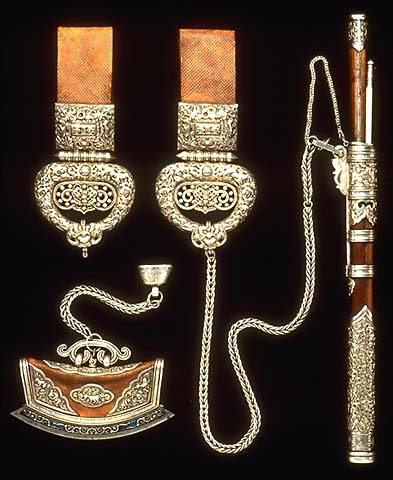Museum of Mongolian History, Ulaanbaatar
|
Like most Asian garments, the Mongolian del does not have pockets, so important utensils such as eating sets and flint pouches are attached to one's sash by means of pendants and toggles. This eating set and flint pouch originally hung from two pendants by means of two long silver chains with hooks ornamented with luck-bringing bats. The pendants are worn on either side of the body, threaded onto loops of the sash through Russian ox hide. When not in use, the eating set is stuck into the folds of the sash and the flint pouch is worn at the back. Mongolians, like the nomadic Tibetans and Manchurians, use an ingeniously designed eating set, which comprises a sharp knife and a pair of chopsticks, and which sometimes includes a toothpick, ear scratcher, and tweezer. The wooden container for the knife and ivory chopsticks is encased in silver. A silver loop locks the knife and chopsticks in place so that they will not fall out when the owner is on horseback or engaged in other vigorous activities. The decorations show strong Chinese influence. The top band is ornamented with symbols of the four literary pursuits of the Chinese scholar--the seven-stringed qin, chessboard, a case of books, and two painting scrolls. The twelve zodiac animals, in two rows, decorate the bottom casing. They are shown against a background of lotus and leafy scrolls, below which is a band of the mountains-and-waves motif. The knife has an ebony handle. Its butt bears a lotus and leaf motif. The top portions of the chopsticks are ornamented with the wealth-bringing coin motif. Before the appearance of matches and lighters, the tinder pouch, or flint and steel set, was an essential piece of equipment, consisting of a small leather pouch with a strip of steel on its lower edge. The pouch, when in use, contained small chips of flint and dried material such as shredded bark, mugwort (Artemisia vulgaris), and edelweiss blossom for use as tinder. In order to create a spark, a piece of tinder is pressed against a chip of flint held in the left hand, and the chip is hit a glancing blow with the steel edge of the pouch, held in the right hand.(1) The spark will cause the tinder to smoulder, and with it one can light a pipe or a fire. The silver repousse Engrave; on the pouch shows the twelve animals of the zodiac, and the steel piece is inlaid with silver filigree and blue enamel. The braided silver chain, attached to the pouch, terminates in a silver toggle in the shape of an ingot (M: jamba). The toggle, inserted first under and then over one's sash, keeps the pouch in place. This set of unusually large ornaments and utensils was specially made by a Mongol craftsman for the giant Ondor Gongor, a bodyguard of the Bogdo Khan when the Mongolian government delegation visited Russia in 1918. Between 1924 and 1972 the set was in a private Hungarian collection, from which the Museum of Mongolian History bought it in 1972. Published: Tsultem, Mongolian Arts and Crafts, pl. 64 |
